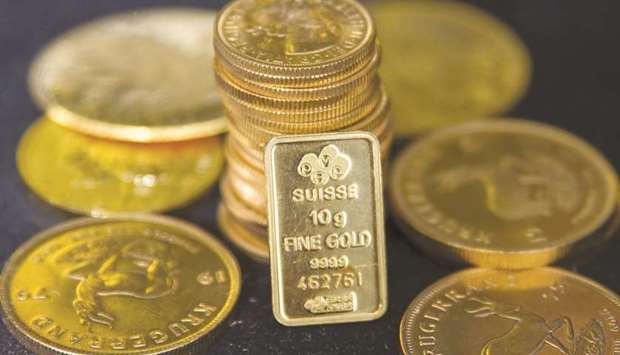A regional divide is brewing in gold-backed funds. US investors are fleeing exchange-traded funds backed by the metal, while their European counterparts are stepping up purchases. Moves in the biggest ETFs in each area underscore the point, with money leaving SPDR Gold Shares for two straight weeks, even as bullion prices rebounded, while the Frankfurt- listed Xetra-Gold had its biggest weekly inflow since February.
The divergence is playing out across gold ETF markets as American investors focus on the prospect of rising US borrowing costs, which curb the appeal of non-interest-bearing bullion. Their counterparts in Europe are weighing the risks from Brexit and Catalonia’s claims to independence from Spain, boosting demand for bullion as a haven.
“Gold is a catastrophe insurance,” Chris Gaffney, the St Louis-based president of EverBank World Markets, said in a telephone interview. “European investors have more to worry about with Catalan. Things are still pushing forward in the US There’s less things to worry about here. Those fund flows would reflect that.”
SPDR Gold, the world’s largest bullion-backed ETF, had outflows of $40mn last week, taking withdrawals this month to $464mn, the most since July. Xetra-Gold attracted $95mn last week, taking this year’s inflows to $2.18bn, the most among its peers around the world.
Right now, the Europeans hold more sway. Total holdings in all gold ETFs tracked by Bloomberg rose for a fourth straight session as of Thursday, the longest streak of gains in almost a month. On Friday, gold for immediate delivery fell 0.5% to $1,283.84 an ounce, heading for a fifth weekly decline in six, according to Bloomberg generic pricing.
European equities fell on Thursday as the Spanish government said it plans to deploy the most wide-ranging constitutional powers for the first time in its history to quash the Catalan separatist movement. That helped boost haven demand for god.
Meanwhile, talks on UK’s exit from the European Union are deadlocked over the financial settlement that the EU wants the UK to pay when it leaves. The EU won’t move on to discuss future trade relationship between the two until it has seen “sufficient progress” on three divorce issues, the trickiest of which is the bill.
Another reason for the divergence in fund flows could be European’s buy-and-hold mentality toward their gold investments, while US investors tend to actively trade the funds, James Butterfill, the head of research and investment strategy at ETF Securities in London, said in an email.
Through all the ups and downs in gold prices since the start of 2016, Xetra-Gold has seen inflows every month except for September. That helped more than triple the fund’s total assets in less than two years. The secret may be in the growing popularity of the metal in Germany.
Over the past 10 years, German investors have turned to gold to protect their wealth, and the metal has attracted even the nation’s lower-income earners, according to a World Gold Council report. In 2016, each German bought about 1.5 grams of gold on average, more than twice as much as the Chinese and three times the purchases of Indians, traditionally among the world’s biggest gold consumers, according to a report on the Xetra-Gold website.
In London, ETFS Physical Gold has attracted about $133mn so far in October, on course for the biggest monthly inflow since August 2016. Source Physical Gold has seen inflows of $147mn, set for the most in two months.
The diverging outlook on gold mirrors the clash between American and European bankers at the Institute of International Finance’s annual meeting last week. JPMorgan Chase & Co chief executive officer Jamie Dimon and some of his deputies were among those saying a coordinated period of global growth is underway for the first time in more than 12 years. UBS Group chairman Axel Weber sees “storm clouds gathering,” while Banco Santander chairman Ana Botin warned that the Continent continues to be riddled with risk.
While Europe is grappling over the uncertainties from Brexit, the US economy has gained some traction this year, allowing the Federal Reserve to increase interest rates.

The divergence is playing out across gold ETF markets as American investors focus on the prospect of rising US borrowing costs, which curb the appeal of non-interest-bearing bullion


